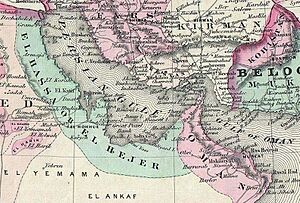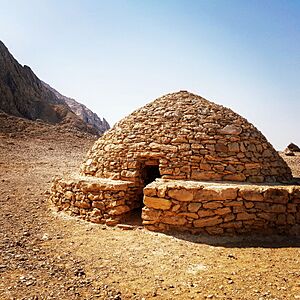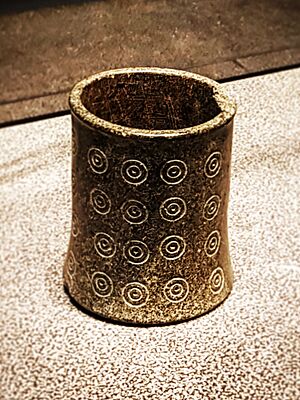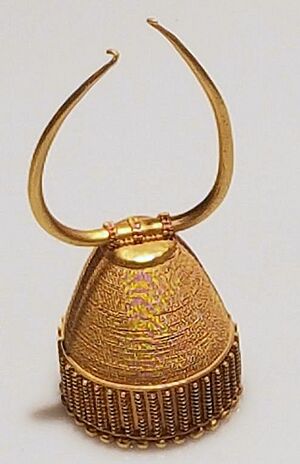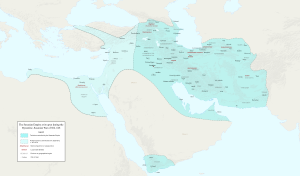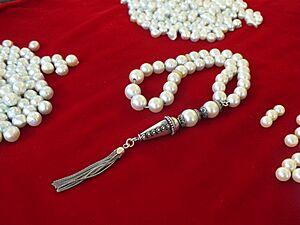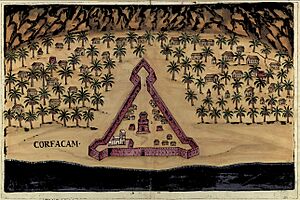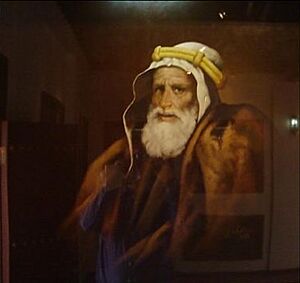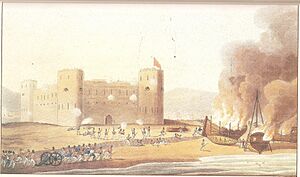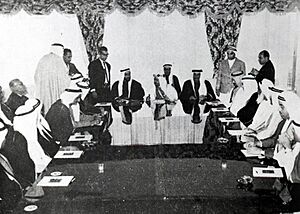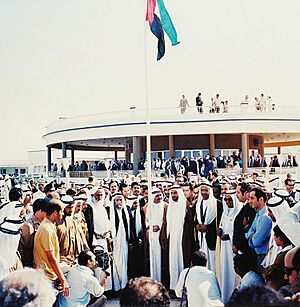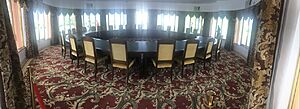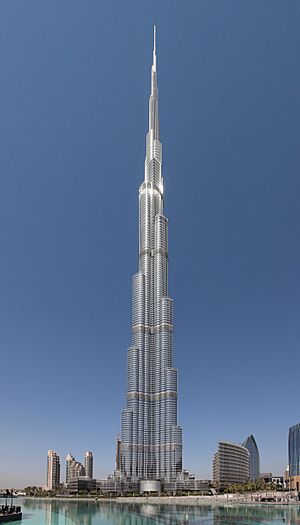History of the United Arab Emirates facts for kids
The United Arab Emirates (often called the UAE or the Emirates) is a country in the Arabian Peninsula. It's located on the southeastern coast of the Persian Gulf and the northwestern coast of the Gulf of Oman. The UAE is made up of seven different areas called emirates. It was formed on December 2, 1971, as a group of states working together, after the United Kingdom's armed forces left the region.
Six of the seven emirates (Abu Dhabi, Dubai, Sharjah, Ajman, Umm Al Quwain and Fujairah) announced their union on December 2, 1971. The seventh emirate, Ras al Khaimah, joined later on February 10, 1972. Before this, these seven areas were known as the Trucial States. This name came from the peace agreements they made with the British in the 1800s.
Archaeological finds in the UAE show that people have lived, moved through, and traded in this area for over 125,000 years. Long ago, the Magan people lived here. They were known to the Sumerians and traded with towns along the coast and with people who mined and melted bronze further inland. Evidence also shows a rich history of trade with the Harappan culture from the Indus Valley, including jewelry and other items. There's also proof of early trade with Afghanistan, Bactria, and the Levant (an area in the Middle East).
Through different periods, including the Iron Age and the Hellenistic period (when Greek culture was important), this area remained a key trading spot. In the 7th century, the area became Islamic after the Al Azd tribe accepted the message of Muhammed. This was made stronger by battles like the Ridda Wars and the important Battle of Dibba. During the Islamic era, the area became a major trade center, especially around the ports of Julfar, Dibba, and Khor Fakkan. These ports were part of a large trading network that connected the East with Europe. Later, small trading ports grew, and farming developed in inland oases like Liwa, Al Ain, and Dhaid. Bedouin tribes lived alongside settled people in coastal areas.
Later, the Portuguese, led by Afonso de Albuquerque, arrived and disrupted the Arab trade networks. This caused trade to decline and led to more conflicts. Conflicts between the coastal communities and the British led to the British attacking Ras Al Khaimah in 1809 and again in 1819. This resulted in the first of many treaties between the British and the local rulers in 1820, starting with the General Maritime Treaty of 1820. These treaties brought peace and prosperity to the coast. They also supported a thriving trade in high-quality natural pearls and other regional goods. Another treaty in 1892 gave the British control over the region's foreign relations, making it a British protectorate.
In early 1968, the British decided to withdraw from the Trucial States. This led to the idea of forming a federation. Sheikh Zayed bin Sultan Al Nahyan of Abu Dhabi and Sheikh Rashid bin Saeed Al Maktoum of Dubai, two influential rulers, agreed to this. They invited other rulers to join. For a while, it seemed like Bahrain and Qatar might also join, but they eventually chose to become independent countries.
Today, the UAE is a modern country that exports oil. It has a very diverse economy. Dubai, in particular, has become a global city and a major center for tourism, shopping, and finance. It is home to the world's tallest building and one of the largest man-made seaports.
Contents
- Ancient History
- Bronze Age: Umm Al Nar and Wadi Suq Cultures
- Iron Age
- Mleiha and the Kingdom of Oman
- Arrival of Islam and the Middle Ages
- The Pearling Industry and Portuguese Influence: 16th - 18th Century
- British Influence: 19th - 20th Century
- Independence and Union: 1960 - 1971
- 21st Century
- See also
Ancient History
Archaeologists found ancient hand-axes and other tools at the Jebel Faya site in the UAE in 2011. These tools look like those used by early humans in East Africa. Scientists used a method called thermoluminescence dating to find out that these tools are 125,000 years old. This is some of the earliest evidence of modern humans found outside Africa. It suggests that modern humans left Africa much earlier than people thought. The site where these tools were found is now protected. It also contains discoveries from later cultures, including tombs from the Hafit, Umm Al Nar, Wadi Suq, Iron Age, Hellenistic, and Islamic periods. These are all displayed at Sharjah's Mleiha Archaeological Centre.
Ice Age and Early Settlements
During the last major Ice Age, from 68,000 to 8000 BCE, it's believed that Eastern Arabia was too harsh for people to live in. However, tools and pottery from the Stone Age and Ubaid cultures (5000 to 3100 BCE) show that humans lived here. These finds connect the early settlements in the Gulf to those in Mesopotamia (modern-day Iraq). The archaeological record shows that this period ended suddenly around 3800 BC, possibly due to climate change.
In the Baynunah Formation area of Abu Dhabi, scientists found a site where camels were slaughtered about 6,000 years ago. This shows early human activity in the region.
Hafit Period
The Hafit period followed a time when there was little evidence of human life on the west coast of the Emirates, possibly due to climate change. When people returned, the Hafit period began. It's named after many unique beehive-shaped tombs found in the mountains of Jebel Hafeet in Al Ain Region. Pottery found here shows continued connections to Mesopotamia. This period marks the early Bronze Age in the UAE and Oman, from 3,200 to 2,600 BC. Hafit tombs and remains have also been found in other places across the UAE and Oman, like Bidaa bint Saud, Jebel Buhais, and Buraimi.
Bronze Age: Umm Al Nar and Wadi Suq Cultures
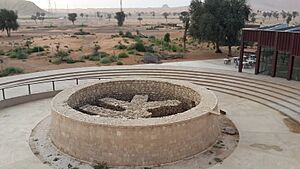
The Umm Al Nar culture was a Bronze Age civilization that existed from about 2600 to 2000 BCE in what is now the UAE and Oman. It's named after an island near Abu Dhabi. The main site is protected, but it's hard for the public to visit right now. The UAE government plans to make it more accessible. A key feature of the Umm Al Nar culture is their circular tombs, built with carefully placed stones, which held many human remains.
The Umm Al Nar culture lasted for about 600 years. During this time, there's a lot of evidence of trade with the Sumerian and Akkadian kingdoms, as well as with the Indus Valley. The people of Umm Al Nar became more advanced, even domesticating animals.
After Umm Al Nar came the Wadi Suq culture, which was important in the region from 2000 to 1300 BC. Major trading cities from both periods have been found on both the western and eastern coasts of the UAE and in Oman. These include Dalma, Umm Al Nar, Sufouh, Ed Dur, Tell Abraq, and Kalba. Burial sites in Ras Al Khaimah show how the Umm Al Nar culture changed into the Wadi Suq culture.
During the Wadi Suq era, camels and other animals were domesticated. This led to more settlements inland and the farming of different crops, including date palms. People also became better at working with metals, pottery, and stone, creating more advanced weapons and tools. However, evidence of strong trade links with the Indus Valley and Mesopotamia became less common.
Iron Age
From 1200 BC until Islam arrived in Eastern Arabia, the area went through three distinct Iron Ages (Iron Age 1, 2, and 3). During this time, the region was sometimes controlled by the Achaemenid and other groups. Fortified settlements were built, and farming became widespread thanks to the development of the falaj irrigation system. Early examples of these waterways, especially around the city of Al Ain, are thought to be some of the oldest ever built. Important Iron Age sites in the UAE have provided many valuable finds for archaeologists. One notable site is Saruq Al Hadid in Dubai, which was a major center for metalworking. Other important Iron Age settlements include Al Thuqeibah, Bidaa bint Saud, Ed-Dur, and Tell Abraq.
Mleiha and the Kingdom of Oman
Beginning around 300 BC, archaeological evidence shows a large city at Mleiha in Sharjah. At first, most buildings were not permanent. However, large stone and mud-brick tombs were built, suggesting that people could build permanent structures but chose a nomadic lifestyle. The design of these tombs is similar to other ancient sites in Arabia, like Qaryat Al Faw, Hegra, and Petra. This might mean there was a shared culture across Arabia that started in Mleiha.
Many large buildings were found at Mleiha, including forts, palaces, homes, and tombs. Mleiha also seems to have been closely connected to the ancient city of Ed-Dur. Ed-Dur might have been a port town controlled by Mleiha, serving as the main center for sea trade. Various artifacts found outside Mleiha show it was a key part of an ancient trade route. Greek wine jars and Greek-style coins indicate a strong Greek influence in the region. The royal family spoke Greek, but most people read and wrote in South Arabian or Aramaic.
The Kingdom of Oman
Memorial and tomb of ʿAmud son of Gurr son of ʿAli, inspector of the king of Oman, which built over him his sonʿAmud son of ʿAmud son of Gurr,inspector of the king of Oman... —Funerary Tablet, from the Tomb of Amud, 215 BC.
Inscriptions from the mid-2nd century BC mention a major kingdom in Mleiha called “Uman.” This kingdom is believed to be the first nation of Oman. It covered much of modern-day UAE and the northern parts of Oman. Greek writers like Pliny the Elder and Strabo also mentioned this kingdom as Omana. Coins were minted in Mleiha, mixing Greek and Arabian styles. These coins were issued under the name Abiel, the ruling family of the Kingdom of Oman. Large palace complexes were built for the rulers. However, after the 3rd century AD, the entire site seems to have been abandoned, marking the fall of the kingdom.
Arrival of Islam and the Middle Ages
Hafit {Tuwwam} abounds in palm trees; it lies in the direction of Al-Hajar {Al Hasa}, and the mosque is in the markets ... Dibba and Julfar, both in the direction of the Hajar, are close to the sea ...|Al-Muqaddasi, 985 CE.
In 632 CE, messengers from Muhammad arrived, leading to the region's conversion to Islam. After Muhammad's death, one of the main battles of the Ridda Wars was fought at Dibba, on the east coast of what is now the Emirates. The defeat of the non-Muslims in this battle led to Islam becoming the main religion in the Arabian Peninsula.
Over many centuries, Julfar grew into a rich port and pearling center. From here, traditional boats called dhows traveled throughout the Indian Ocean.
The Pearling Industry and Portuguese Influence: 16th - 18th Century
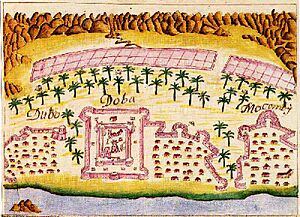
The pearling industry was a key part of the economy for coastal communities across Eastern Arabia. It thrived during peaceful times at sea, providing jobs and income. About two to three thousand local ships were involved in collecting pearls each season. The annual income was very high, and workers in Julfar and nearby areas were often paid in pearls instead of money. In 1907, around 4,500 pearling boats were operating from Gulf ports, employing over 74,000 men.
Pearling Centers and Trade
The main pearling centers stretched from Bida (Doha) to Dubai. The most important season was in Dalma, known as al-ghaws al-kabir (The Great Dive). As demand grew in India and Europe, pearlers started exploring more distant areas, including those near Abu Dhabi and Dubai. This growth in international trade strengthened the power of local rulers. Fleets stayed at sea from June to late September, and every able-bodied man joined. Pearling provided 80% of Sheikh Zayed bin Khalifa Al Nahyan's (Zayed the Great) income, giving him great influence.
The Portuguese Empire took control of the tax system on the northern coast from 1523 to 1622. They continued to collect revenue until the early 1700s. The Portuguese issued navigation permits called Cartazes and collected taxes called Magumbayas. Centers for these permits and taxes were in ports from Julfar to Khasab. On the Persian coast, the Portuguese did the same for Arab traders. Any ship sailing without a Portuguese license could be captured by their navy. This fear of the Portuguese navy led to their control over sea trade.
Pearling Culture and Decline
At the start of the pearling season, from June to September, thousands of local ships would gather. They would bring enough supplies for up to three months at sea. A start date was agreed upon, and big celebrations were held, along with religious ceremonies and traditions to protect divers from sharks. The ships would then spread out on a clear, calm day.
Each ship carried divers who would dive to the seabed to collect pearls. To help them reach the bottom, two heavy stones were tied to the diver's feet, and a rope was tied to their waist. People on the ship held the rope and would pull the diver up. When the pearl bag was full, the diver would signal to be pulled up. Those pulling had to be quick to prevent the diver from running out of oxygen.
The pearling industry began to decline when Japanese cultured pearls became available in the late 1920s. These inexpensive, high-quality pearls flooded the world markets. This, along with the Great Depression, severely damaged the Gulf's pearl markets. In 1929, many pearling boats in Dubai stayed in port all season.
The complex system of financing the pearling industry broke down. This left many working men facing poverty. The pearling industry also used slave labor. In the 1930s, many enslaved people sought freedom from the British, showing the difficult situation of the pearling fleet owners.
British Influence: 19th - 20th Century
Attempts by the Ottoman Empire to expand into the Indian Ocean failed. Instead, Portuguese expansion in the early 1500s led to them attacking many coastal towns. After this, the Al Qasimi, a seafaring tribe from the Northern Peninsula, controlled the southern Gulf waterways. This continued until British ships arrived and clashed with them.
The British then called the region the "Pirate Coast" because Al Qasimi raiders attacked shipping, despite British navy patrols. Several conflicts happened, especially between 1809 and 1819.
British Campaigns and Treaties
After years of incidents where British ships were attacked by the Al Qasimi, a British force went to Ras Al Khaimah in 1809. This led to a peace treaty between the British and Hussan Bin Rahmah, the Al Qasimi leader. However, this peace broke down in 1815. Historian J. G. Lorimer said that after the agreement ended, the Al Qasimi engaged in "maritime lawlessness."
In November 1819, the British launched another expedition against the Al Qasimi. Major General William Keir Grant led 3,000 soldiers and warships to Ras Al Khaimah. The British offered Said bin Sultan of Muscat control of the Pirate Coast if he helped them. He sent 600 men and two ships.
After Ras Al Khaimah fell and Dhayah Fort surrendered, the British set up a military base there. They then destroyed the forts and large ships of Umm Al Qawain, Ajman, Fasht, Sharjah, Abu Hail, and Dubai. Ten ships hiding in Bahrain were also destroyed.
As a result of this campaign, a peace treaty was signed the next year with all the sheikhs of the coastal communities. This was the General Maritime Treaty of 1820.
This treaty only protected British ships and did not stop conflicts between local tribes. So, raids continued until 1835, when the sheikhs agreed to stop fighting at sea for one year. This truce was renewed every year until 1853.
Perpetual Maritime Truce and Exclusive Agreement
In 1853, the Perpetual Maritime Truce was signed. It banned any attacks at sea. This treaty was signed by the rulers of Umm Al Quwain, Ajman, Dubai, Abu Dhabi, and Ras Al Khaimah. More agreements followed, including one to stop the slave trade in 1856 and another in 1864 to protect telegraph lines.
In 1892, the 'Exclusive Agreement' was signed. This agreement meant that the rulers could not make any deals or communicate with any country other than Britain. They also could not allow any other government's agent to live in their territory, nor could they sell or give away any land except to the British government. In return, the British promised to protect the Trucial Coast from sea attacks and help if there was a land attack.
Trucial States Affairs and Oil Discovery
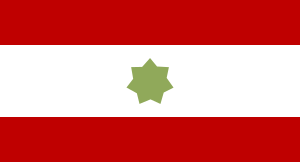
The treaties with the British mainly focused on sea matters. The Trucial Rulers were free to manage their own internal affairs. However, they often asked the British for help in their frequent disputes, especially when these disputes involved debts to British and Indian citizens.
Over time, some smaller emirates became part of larger ones. For example, Fujairah was not recognized as a Trucial State until 1952, and Kalba, recognized in 1936, is now part of Sharjah.
Until the 1930s, the British did not interfere much in the internal affairs of the Trucial Sheikhdoms, as long as peace was kept.
In the 1930s, oil companies began exploring the area. An agreement for onshore oil exploration was made in 1939, and for offshore exploration in 1952. Only British companies were allowed to explore for oil. In 1947, the British government's management of the Trucial Coast moved from Bombay to London. A British Political Officer was based in Sharjah from 1937 to manage daily affairs.
Oil was found offshore at Umm Shaif in 1958 and in the desert at Murban in 1960. The first oil was exported from Abu Dhabi in 1962. As oil money increased, Sheikh Zayed bin Sultan Al Nahyan, the ruler of Abu Dhabi, started huge building projects, including schools, homes, hospitals, and roads. When Dubai began exporting oil in 1969, Sheikh Rashid bin Saeed Al Maktoum, the ruler of Dubai, also used the oil money to improve life for his people.
Buraimi Dispute
In 1952, about 80 Saudi Arabian guards, led by Turki Abdullah al Otaishan, entered Abu Dhabi territory. They occupied Hamasa, one of three Omani villages in the Oasis, claiming it was part of Saudi Arabia. The Sultan of Muscat and Imam of Oman wanted to remove the Saudis, but the British government convinced them to wait for a peaceful solution. British military forces gathered, leading to a temporary agreement and the dispute being sent to an international court. In 1955, the court proceedings began but failed. A few weeks later, the Saudi group was forced out of Hamasa by the Trucial Oman Levies.
The dispute was finally settled in 1974 by an agreement between Sheikh Zayed (then President of the UAE) and King Faisal of Saudi Arabia.
Independence and Union: 1960 - 1971
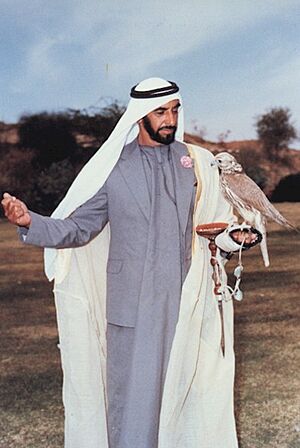
In the early 1960s, oil was found in Abu Dhabi. This led to quick calls for the UAE sheikhdoms to unite. Sheikh Zayed bin Sultan Al Nahyan became the ruler of Abu Dhabi in 1966. Around this time, the British began losing their oil investments to U.S. oil companies.
The British had set up a development office to help the emirates. The sheikhs then decided to form a council to work together and took over this office. They created the Trucial States Council. This council ended when the United Arab Emirates was formed.
British Withdrawal
By 1966, the British government decided it could no longer afford to govern what is now the United Arab Emirates. Many discussions took place in the British parliament. Some members argued that the Royal Navy could not defend the Trucial Sheikhdoms. On January 16, 1968, British Prime Minister Harold Wilson announced the decision to end the treaties with the seven Trucial Sheikhdoms, which had been under British protection. This decision was confirmed in March 1971 by Prime Minister Edward Heath.
The region faced many serious local and regional problems. Iran claimed Bahrain and other islands in the Gulf. Qatar and Bahrain had land disputes, and the Buraimi dispute was still ongoing. The rulers of the emirates believed that Britain's presence guaranteed the region's safety. Some truly wanted Britain to stay. Days after the British announcement, Sheikh Zayed offered to pay all costs for British armed forces to remain in the Emirates. However, the British government refused the offer.
Federation of Nine Emirates
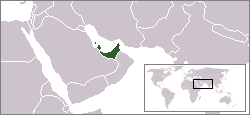
After the British announced their withdrawal, the nine Persian Gulf sheikhdoms tried to form a federation of Arab emirates. This idea was first suggested in February 1968 when the rulers of Abu Dhabi and Dubai met and agreed to unite. They invited other Gulf states to join. Later that month, the rulers of Bahrain, Qatar, and the Trucial Coast met. Qatar suggested forming a federation governed by a council of nine rulers. This idea was accepted, and a declaration of union was approved. However, there were disagreements about the capital city, the constitution, and how to share government roles.
More political problems arose as Bahrain tried to take a leading role. There were also differences between the rulers of the Trucial Coast, Bahrain, and Qatar, especially over the Hawar Islands. While Dubai's ruler, Sheikh Rashid, had strong ties to Qatar's ruling family, the relationship between Abu Dhabi and Dubai remained strong. There were only four meetings among the nine rulers. At the last meeting in Abu Dhabi, Zayed bin Sultan Al Nahyan was chosen as the first president of the federation. Many issues remained unresolved, such as the vice-president's position and the federation's defense.
Soon after, the British government's interest in the meeting's outcome was revealed. Qatar then withdrew from the federation, seemingly because of what it saw as foreign interference. The nine-emirate federation broke up despite efforts by Saudi Arabia, Kuwait, and Britain to restart discussions. Bahrain became independent in August 1971, and Qatar in September 1971.
Declaration of the Union 1971–1972
On November 29 and 30, 1971, the Iranian army and navy occupied the islands of Abu Musa and the Lesser and Greater Tunbs. In Greater Tunb, six policemen fought with about 2,000 Iranian troops. Four Ras Al Khaimah policemen and three Iranian soldiers were killed. The Iranian troops then destroyed the police station, school, and some houses, forcing the residents to leave. The first soldier killed on Greater Tunb was Salem Suhail bin Khamis, who died after refusing to lower the Ras Al Khaimah flag. His death is marked as the date of the first martyr in the UAE, and November 30 is celebrated as Commemoration Day. The ruler of Sharjah had to agree to negotiate for Iranian troops to occupy Abu Musa.
When the British treaties with the Trucial Sheikhdoms ended on December 1, 1971, the Trucial States became independent. Four more Trucial states (Ajman, Sharjah, Umm Al Quwain, and Fujairah) joined Abu Dhabi and Dubai in signing the UAE's founding treaty. A draft constitution was quickly prepared to meet the December 2, 1971, deadline. On that day, at the Dubai Guesthouse (now Union House), the emirates agreed to form a union called the United Arab Emirates. Ras al-Khaimah joined in February 1972.
On January 24, 1972, the former ruler of Sharjah, Sheikh Saqr bin Sultan Al Qasimi, with an armed group, forced his way into the palace of Sharjah's ruler, Sheikh Khalid bin Mohammed Al Qasimi. He occupied it and demanded to be recognized as the sole ruler of Sharjah. Saqr had been removed from power in 1965 by the British because he supported the Arab League, which Britain opposed. He saw this as a chance to return since the British had ended their commitments. This incident led to the UAE defense force mobilizing for the first time. This force, along with the Abu Dhabi defense force and local resistance in Sharjah, brought the situation under control. Sheikh Khalid, Sharjah's ruler, was killed in the palace. This attack on a member emirate and the murder of a ruler tested the new union. On January 25, 1972, the ruling family in Sharjah chose Sheikh Sultan bin Muhammad Al-Qasimi, the late ruler's brother, to succeed him. The Supreme Council met and officially announced his accession.
The move to form a union happened during a very unstable time in the region. There was a border dispute that caused 22 deaths in Kalba, and a coup in Sharjah in January 1972. The ruler of Qatar was also removed from power by his cousin in February 1972.
21st Century
Early 2000s
After the 9/11 terrorist attacks in the United States, the UAE was identified as a major financial center used by Al-Qaeda to transfer money. The UAE immediately worked with the United States, freezing accounts linked to suspected terrorists and cracking down on money laundering. The country had already signed military defense agreements with the United States in 1994 and with France in 1977.
The UAE supported military operations by the United States and other countries in the invasion of Afghanistan (2001) and Iraq (2003). It also supported operations against terrorism in the Horn of Africa from Al Dhafra Air Base near Abu Dhabi. This air base also supported Allied operations during the 1991 Persian Gulf War.
On November 2, 2004, the UAE's first president, Sheikh Zayed bin Sultan Al Nahyan, passed away. His eldest son, Sheikh Khalifa bin Zayed Al Nahyan, became the ruler of Abu Dhabi. According to the constitution, the UAE's Supreme Council of Rulers elected Khalifa as president. Sheikh Mohammad bin Zayed Al Nahyan became the Crown Prince of Abu Dhabi. In January 2006, Sheikh Maktoum bin Rashid Al Maktoum, the prime minister of the UAE and ruler of Dubai, died. Crown Prince Sheikh Mohammed bin Rashid Al Maktoum took on both roles.
In March 2006, the United States required the state-owned Dubai Ports World to give up control of terminals at six major American ports. Critics of the deal worried about an increased risk of terrorist attacks, as the UAE had been home to two of the 9/11 hijackers.
In December 2006, the UAE held its first election to choose half the members of its Federal National Council. Only 7,000 Emirati citizens, less than 1% of the population, were allowed to vote. Women were included in the voters.
2011 Onwards
In August 2011, many pro-democracy protests, known as the Arab Spring, happened across the Middle East. The UAE had relatively little unrest. However, five political activists were arrested for insulting heads of state, including the UAE president, by running an anti-government website. The trial of the UAE Five gained international attention, and human rights groups called them prisoners of conscience. The defendants were found guilty and given prison sentences in November 2011.
On September 25, 2019, Hazza Al Mansouri launched into space aboard the Soyuz MS-15 spacecraft to the International Space Station. He stayed for eight days, becoming the first Emirati in space.
The first confirmed COVID-19 case in the United Arab Emirates was announced on January 29, 2020. It was the first country in the Middle East to report a case.
The Emirates Mars Mission is a United Arab Emirates Space Agency mission to Mars. The Hope probe was launched on July 19, 2020, and entered orbit around Mars on February 9, 2021. On that day, the UAE became the first Arab country and the fifth country to reach Mars. It was also the second country to successfully enter Mars' orbit on its first try, after India. In April 2023, The New York Times reported a new global map of Mars based on images from the Hope spacecraft.
In 2020, a UK court ruled that Sheikh Mohammed bin Rashid Al Maktoum had kidnapped and imprisoned his daughters, Shamsa and Latifa.
In the early 2020s, the UAE began updating its laws. It allowed foreigners to follow their home country's family laws for marriage and inheritance instead of local Sharia law. It also allowed unmarried couples to live together. Economic changes now allow foreigners to own businesses without a UAE partner. At the start of 2022, the weekend changed to Saturday-Sunday, with Friday as a working half-day. While homosexuality remains illegal, and freedom of speech is not fully guaranteed, the UAE continues to address human rights concerns.
Expo 2020 was a World Expo hosted by Dubai from October 1, 2021, to March 31, 2022. It was originally planned for 2020 but was postponed due to the COVID-19 pandemic in the United Arab Emirates. Despite the delay, it kept the name Expo 2020 for marketing. The event had over 24 million visits in its six months.
The Museum of the Future was opened by the Government of the United Arab Emirates on February 22, 2022. This date was chosen because it is a palindrome date (reads the same forwards and backward). It is a famous building in Dubai dedicated to new and future ideas. It has three main parts: a green hill, the building itself, and a unique empty space.
On May 14, 2022, Sheikh Mohamed bin Zayed Al Nahyan was elected as the UAE's president after the death of Sheikh Khalifa bin Zayed Al Nahyan.
The Emirates Lunar Mission was the first mission to the Moon from the UAE. The mission sent a lunar rover named Rashid to the Moon aboard ispace's Hakuto-R Mission 1 lander. It launched on December 11, 2022. The rover tried to land in Atlas crater. On April 25, 2023, communication with the lander was lost seconds before it was supposed to land. The team confirmed that the spacecraft had crashed into the Moon.
See also
 In Spanish: Historia de los Emiratos Árabes Unidos para niños
In Spanish: Historia de los Emiratos Árabes Unidos para niños
- History of Asia
- History of the Middle East
- History of Dubai and Timeline of Dubai
- History of Ras Al Khaimah
- History of Oman
- Timeline of Abu Dhabi
- Archaeology of the United Arab Emirates
- History of the Middle East
- List of presidents of the United Arab Emirates
- List of prime ministers of the United Arab Emirates
- National Center for Documentation and Research
- Politics of the United Arab Emirates


